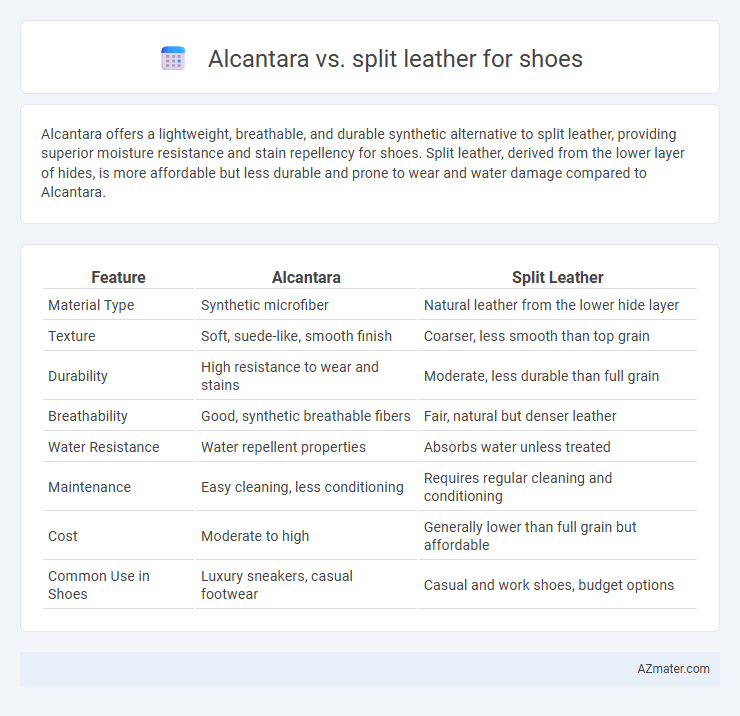Alcantara offers a lightweight, breathable, and durable synthetic alternative to split leather, providing superior moisture resistance and stain repellency for shoes. Split leather, derived from the lower layer of hides, is more affordable but less durable and prone to wear and water damage compared to Alcantara.
Table of Comparison
| Feature | Alcantara | Split Leather |
|---|---|---|
| Material Type | Synthetic microfiber | Natural leather from the lower hide layer |
| Texture | Soft, suede-like, smooth finish | Coarser, less smooth than top grain |
| Durability | High resistance to wear and stains | Moderate, less durable than full grain |
| Breathability | Good, synthetic breathable fibers | Fair, natural but denser leather |
| Water Resistance | Water repellent properties | Absorbs water unless treated |
| Maintenance | Easy cleaning, less conditioning | Requires regular cleaning and conditioning |
| Cost | Moderate to high | Generally lower than full grain but affordable |
| Common Use in Shoes | Luxury sneakers, casual footwear | Casual and work shoes, budget options |
Introduction to Alcantara and Split Leather
Alcantara is a premium synthetic material known for its soft texture, durability, and resistance to wear, making it ideal for high-end shoe uppers and linings. Split leather, derived from the fibrous lower layer of animal hide, offers an affordable alternative with a suede-like finish but generally lacks the strength and longevity of top-grain leathers. Understanding the differences in composition and performance between Alcantara and split leather helps consumers select footwear materials based on durability, comfort, and aesthetic preferences.
Key Material Differences: Alcantara vs Split Leather
Alcantara is a premium synthetic material made from polyester and polyurethane, offering a soft, suede-like texture with high durability and stain resistance, making it ideal for luxury shoe linings and uppers. Split leather, derived from the fibrous lower layers of the hide, is less durable and porous compared to full-grain leather, frequently used for economical shoe components but prone to wear and moisture damage. The key material differences lie in Alcantara's synthetic origin and maintenance ease versus split leather's natural hide source and susceptibility to aging and surface degradation.
Durability Comparison in Footwear
Alcantara offers superior durability in footwear due to its high resistance to abrasion, stains, and fading, making it ideal for long-lasting shoes. Split leather, while more affordable, tends to be less durable as it is prone to peeling and wears out faster under heavy use. Shoe manufacturers often prefer Alcantara for premium, durable shoes requiring both strength and aesthetic appeal.
Comfort and Breathability Factors
Alcantara offers superior breathability thanks to its microfiber structure, allowing better air circulation and moisture management in shoes. Split leather, while durable, tends to retain heat and moisture, reducing overall comfort during extended wear. The plush, soft texture of Alcantara enhances cushioning and flexibility, making it a preferred choice for comfort-focused footwear.
Aesthetic and Texture Variations
Alcantara offers a luxurious, suede-like texture with a smooth, velvety finish that enhances the aesthetic appeal of shoes with a modern, sophisticated look. Split leather, derived from the fibrous part of the hide, presents a rougher, more rugged texture, often used to achieve a casual or vintage style. The aesthetic contrast between Alcantara's sleek, uniform surface and split leather's natural grain and imperfections caters to diverse design preferences and tactile experiences in footwear.
Maintenance and Cleaning Requirements
Alcantara requires gentle cleaning with a soft brush or cloth, avoiding harsh chemicals to maintain its suede-like texture and prevent discoloration. Split leather demands regular conditioning and careful removal of dirt with a damp cloth to preserve its durability and flexibility without cracking. Both materials benefit from prompt stain treatment, but Alcantara is more sensitive to water exposure, whereas split leather needs moisturization to prevent drying and splitting.
Sustainability and Environmental Impact
Alcantara is a sustainable alternative to split leather, made from 68% polyester and 32% polyurethane with a production process that consumes less water and generates fewer emissions compared to traditional leather tanning. Split leather is a byproduct of full-grain leather but involves chemical treatments and heavy water use, contributing to environmental pollution. The biodegradable nature of Alcantara combined with its durability offers a lower carbon footprint and reduced waste in shoe manufacturing.
Pricing and Value Considerations
Alcantara offers a luxurious, suede-like texture at a mid-range price point, appealing to buyers seeking style and comfort without the premium cost of genuine leather. Split leather, derived from the lower layers of cowhide, tends to be more affordable but may sacrifice durability and appearance compared to full-grain leather or Alcantara. Consumers prioritizing long-term value often weigh Alcantara's enhanced aesthetic and resilience against split leather's budget-friendly pricing when selecting footwear materials.
Typical Shoe Applications and Use Cases
Alcantara is favored in high-end sneakers and fashion boots due to its soft texture, durability, and stain resistance, making it ideal for stylish, comfortable footwear that requires a premium appearance. Split leather, commonly used in work boots and casual shoes, offers toughness and abrasion resistance at a lower cost but often requires additional finishing for enhanced durability and water resistance. Typical use cases for Alcantara include luxury and designer shoes emphasizing aesthetics, while split leather is preferred in rugged, practical footwear designed for heavy wear and outdoor activities.
Choosing the Right Material for Your Shoes
Alcantara offers superior breathability, lightweight comfort, and a luxurious texture ideal for stylish, casual shoes, while split leather provides enhanced durability, ruggedness, and resistance to wear, making it suitable for heavy-use footwear. Understanding the shoe's intended purpose is crucial; Alcantara excels in aesthetics and comfort for everyday wear, whereas split leather is optimal for work boots or outdoor shoes requiring toughness. Evaluating factors such as environmental exposure, maintenance needs, and desired longevity ensures selecting the perfect material aligns with functional and stylistic priorities.

Infographic: Alcantara vs Split leather for Shoe
 azmater.com
azmater.com